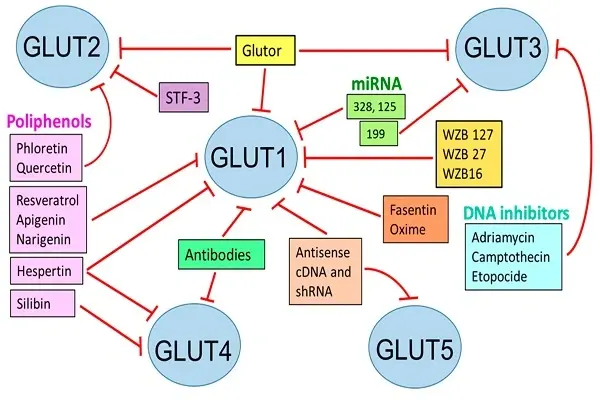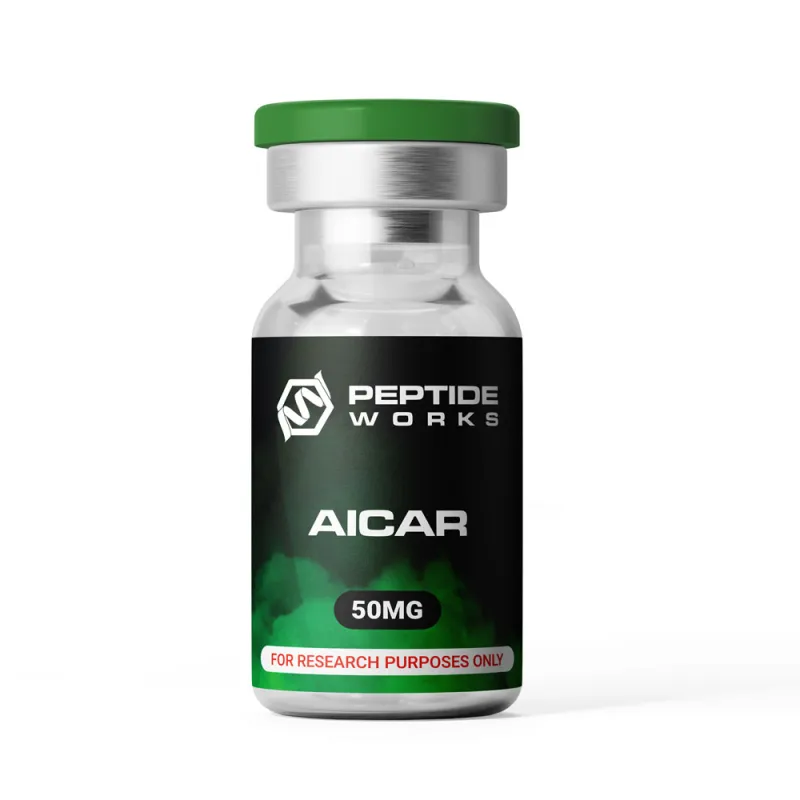
PROMO!
First order? Get 10% OFF with this code: 1storder
Written by

AICAR works as a strong muscle preserving agent in many research studies. It activates AMPK pathways in skeletal muscle cells, helping with energy-related processes.
Research shows that AICAR can mimic the effects of exercise, even without physical movement. This ribonucleoside increases glucose uptake in muscle tissue and supports fatty acid oxidation, which helps energy production.
Studies also show that AICAR helps reduce muscle loss that happens with age. It supports mitochondrial biogenesis in several types of tissue. This helps maintain muscle mass, even during stress.
The way it works is by activating adenosine monophosphate-activated protein kinase (AMPK). However, AICAR is only used for research.
Peptide-Works provides high-quality compounds to researchers worldwide, using reliable shipping. It’s not approved for human use. The muscle-related benefits are seen only in lab tests using intact cells.
Explore AICAR from Peptide Works, a research compound that activates AMPK pathways to preserve muscle and regulate cellular energy.

AMPK pathways function as energy sensors within the body. They detect when cellular energy levels are low. In response to elevated adenosine monophosphate (AMP) concentrations, these pathways initiate glucose uptake. Additionally, they promote fatty acid oxidation in skeletal muscle tissue to support energy demands.
These pathways play a regulatory role in multiple physiological systems. They coordinate the balance between energy generation and energy expenditure. AMPK also influences protein synthesis and oversees energy distribution within cells.
Activation of AMPK promotes catabolic activity while simultaneously inhibiting anabolic processes. This shift conserves energy and ensures efficient cellular function under metabolic stress
AMPK facilitates glucose uptake in muscle cells by promoting the translocation of GLUT4 proteins to the cell membrane functioning much like sliding doors that open to allow glucose entry.
Upon activation, AMPK triggers a cascade of phosphorylation events. These molecular changes drive GLUT4 from intracellular storage compartments toward the plasma membrane.
The process is further modulated by signaling molecules such as nitric oxide and reactive oxygen species. Notably, studies involving compounds like AICAR illustrate how this mechanism operates in leukemia cell models.
In parallel, Humanin supports mitochondrial stability during hypoxic conditions through alternative cellular pathways.
Recent randomized trials have examined the use of AICAR and its related compound aica riboside to better understand the effects of AICAR in cellular systems, including disease research involving chronic lymphocytic leukemia and acute lymphoblastic leukemia. These investigations have highlighted potential applications and provided broader insight into the mechanisms of this compound.
Check out Humanin from Peptide Works, a mitochondrial peptide studied for its protective role in cellular stress and metabolic regulation.

GLUT4 transporters are special proteins in cell membranes that help glucose enter cells. They are made by the SLC2A4 gene and have complex structures that span the membrane.
GLUT4 uses a process called facilitated diffusion. This means glucose moves along its concentration gradient through the cell membrane.
Studies show that GLUT4 stays inside the cell until it gets a signal, a mechanism strongly influenced by AMPK activation and its benefits for diabetes. When activated it moves to the cell surface. Research on acute myeloid leukemia and cell cycle control shows GLUT4 plays a key role in how cells handle glucose. Blocking GLUT4 can disrupt glucose balance in athletes, including cyclists.
Facilitated diffusion helps glucose move into cells. It does not need energy. Glucose moves from areas with more glucose to areas with less. GLUT4 transporters change shape to let glucose pass through cell membranes.
This process has special features. It works fast and well. Studies show it helps keep glucose moving in cells. It uses aica ribonucleotide and adenosine to control how fast glucose moves. This helps cells get energy in many different conditions and situations.
Aica ribonucleotide acts as a key controller of cellular energy production through adenosine kinase pathways. It helps cells make ATP when energy levels drop. This process works well during hypoxia conditions when cells need more energy.
The compound prevents metabolic disorders by controlling energy balance in cells. It also manages reactive oxygen species that can damage cells. Research shows aica ribonucleotide helps with cell cycle energy needs. Studies show this energy control supports muscle function during intense physical activity.

Adenosine kinase is a key enzyme involved in cellular energy production. It converts adenosine into AMP by attaching phosphate groups. This reaction supports energy generation, especially when cells are under stress or increased demand.
The enzyme follows a clear sequence of actions. It first binds to adenosine. Then, using ATP, it transfers phosphate groups to form AMP. This step initiates the energy cycle. Studies in endurance athletes, like cyclists, show that adenosine kinase helps prevent energy depletion during intense training sessions.
Research also highlights its role in controlling energy waste. It regulates energy usage in individuals with heart issues, such as myocardial infarction. By managing metabolic activity, it supports more efficient energy balance.
This peptide plays a key role in reducing cellular energy loss by inhibiting pathways that consume excess energy. It functions like a regulatory switch, deactivating unnecessary energy consuming processes. This mechanism allows cells to conserve energy for essential activities such as muscle repair and contraction.
The compound operates by targeting enzymes involved in inefficient energy use. Studies indicate AICAR may outperform metformin in minimizing energy waste. It has also shown promise in cardiac research, where it helps reduce energy depletion in heart muscle under stress.
In endurance athletes, such as cyclists, AICAR peptide improves endurance by stabilizing energy levels during prolonged exertion. This protective effect reduces cellular damage and promotes balanced energy usage across various tissues.
AICAR research shows strong potential for future medical progress. Researchers are studying how this compound may help with different health issues. Studies suggests AICAR might support treatment for muscle diseases and problems with energy use.
Future studies will look at how AICAR works with other compounds, such as Humanin. Researchers hope to learn how these tools may help individuals with metabolic disorders. New methods in research will improve our understanding of energy in cells and how muscles are protected.
AICAR is still a research-only compound. Peptide Works supports global science by offering reliable access to research peptides and worldwide shipping.
More studies and clinical trials are needed before AICAR is used in real treatments. The compound is still useful for learning how cells create and manage energy. Peptide Works provides 99% purity AICAR for trusted lab studies.
All products discussed are supplied for research purposes only and are not intended for human use.
[1] Aschenbach WG, Hirshman MF, Fujii N, Sakamoto K, Howlett KF, Goodyear LJ. Effect of AICAR treatment on glycogen metabolism in skeletal muscle. Diabetes. 2002 Mar;51(3):567-73.
[2] Wilcox SH, Calixto J, Dray SD, Rasch DM, Smith AH, Brodowski KD, Hill JT, Thomson DM. Chronic treatment of old mice with AICAR reverses age-related changes in exercise performance and skeletal muscle gene expression. FASEB Bioadv. 2025 Jan 29;7(3):e1491.
[3] Višnjić D, Lalić H, Dembitz V, Tomić B, Smoljo T. AICAr, a Widely Used AMPK Activator with Important AMPK-Independent Effects: A Systematic Review. Cells. 2021 May 4;10(5):1095
[4] Kim SJ, Devgan A, Miller B, Lee SM, Kumagai H, Wilson KA, Wassef G, Wong R, Mehta HH, Cohen P, Yen K. Humanin-induced autophagy plays important roles in skeletal muscle function and lifespan extension. Biochim Biophys Acta Gen Subj. 2022 Jan;1866(1):130017.
ALL CONTENT AND PRODUCT INFORMATION AVAILABLE ON THIS WEBSITE IS FOR EDUCATIONAL PURPOSES ONLY.
DISCLAIMER: These products are intended solely as a research chemical only. This classification allows for their use only for research development and laboratory studies. The information available on our Peptide Works website: https://peptide-works.com/ is provided for educational purposes only. These products are not for human or animal use or consumption in any manner. Handling of these products should be limited to suitably qualified professionals. They are not to be classified as a drug, food, cosmetic, or medicinal product and must not be mislabelled or used as such.
Peptide Works
Related Articles

Best Peptides for Women in Perimenopause: From Libido to Energy
Do you feel drained, struggle with focus, or notice your drive slipping during perimenopause? These changes are some of the

PT-141 for Women in Perimenopause: A Breakthrough for Low Libido
Perimenopause can bring more than just physical changes it often affects how women feel about intimacy, confidence, and connection. Many

Can Vitamin B12 Immune System Support Enhance the Effects of Thymosin Alpha-1?
The Vitamin B12 immune system link is important because this vitamin plays a crucial role in DNA synthesis, methylation, energy